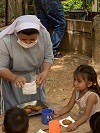aa
walking - Related Content
Discovering a Growing Edge While Walking in Cochabamba
 When I first joined religious life, I remember hearing the term growing edges, referring to where in my life there were opportunities for growth. I couldn’t help but think of a climbing plant continuing to fill in on the edges to grow bigger and more expansive.
When I first joined religious life, I remember hearing the term growing edges, referring to where in my life there were opportunities for growth. I couldn’t help but think of a climbing plant continuing to fill in on the edges to grow bigger and more expansive.
I sometimes have a hard time noticing my growth and change. Once growth happens, it becomes a part of me. It might be a better to say that my growth becomes integrated. So maybe for me it’s more like a forest. Given the opportunity, it spreads out with more and more trees on its edges in slow, less perceptible ways.
Photo credit: Pixabay
Since I have been able to go back to language school, post COVID isolation, I have enjoyed walking to school. It is a joy to be outside in the open air. I get to look at all the activity going on in the city, see people walking, talking, eating and working. I get to enjoy the beautiful gardens and, of course, check out the different birds in the area. There’s actually a part of my walk that goes along a channel and is just FILLED with birds. Most times, I just hear them but sometimes one pops up for me to see. I don’t have my camera along as I walk to school so you’ll just have to take my word for it! But I digress…

Photo: This garden on my walk to school was being weeded by a woman (by hand) the first time I walked by and is now beautiful.
A growing edge I have become aware of this week has become apparent on my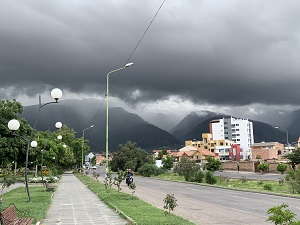 walks. First, it’s important to understand that outside of the people I interact with at school, I rarely see someone that shares my skin tone. To give you an idea, I have been here for 3 weeks and I have seen 3 people outside of the school that share my complexion.
walks. First, it’s important to understand that outside of the people I interact with at school, I rarely see someone that shares my skin tone. To give you an idea, I have been here for 3 weeks and I have seen 3 people outside of the school that share my complexion.
In my mind, I know that it doesn’t matter. Everyone I have had personal contact with has been so full of kindness and hospitality and even with the language barrier, they go out of their way to make me feel welcome. And yet…
Photo: Rain gathering in the mountains.
And yet, as I am walking down the street and pass someone by, many times they don’t make eye contact. For a moment, I wonder if maybe they don’t want to interact with me. Is it because I am different? Sometimes someone does make eye contact and I say Buenos Dias, but they say nothing back. I wonder then if I am doing something wrong because I am not from around here. At a bus stop, as I walk by a couple people sitting and waiting for the bus I say, Buenos Dias, and I can’t be sure, but it seems like an older woman looks me up and down before looking away. I wonder if it’s because of my skin tone, maybe she doesn’t like people that look like me. Maybe I shouldn’t have said hello. I am the outsider in this place. Who am I to think that people should be nice to me?
I live in this mind space for a short time wondering about my place in this country that is not my own, in this place where I am different. This place where I don’t fit in. This place where I am an outsider.
In time, I consider my thinking more deeply. I remember that in the United States, where I am the majority and my skin tone affords me unwarranted privilege, that people don’t make eye contact with me, people don’t say hi back and that sometimes people give me looks I don’t understand. I remember that no matter where I am, there are people who have bad days, who are tired. There are even more in their own thoughts and not noticing the people they meet. In big cities I’ve lived in, it’s rare that people make eye contact or say hello.
Then I decide to stop and look around. I resolve to try to see the similarities I have with the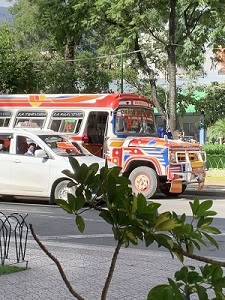 people around me, and not make assumptions about them. I resolve to stop projecting my thoughts on other people. I continue walking.
people around me, and not make assumptions about them. I resolve to stop projecting my thoughts on other people. I continue walking.
Yesterday, I was heading back home and it was raining, so I hailed a crowded bus (that’s how it works here – pretty cool!) and jumped on, paying my 1,50 bolivianos, the equivalent of about 50 cents US. As I hopped up the stairs, a young woman left her seat and moved to the back so I would have a place to sit. I was grateful for the kindness. As we drove through some water that was tumbling down the road, the splashes were pretty spectacular. The older woman I was sitting with and I both said “wow!” in unison as we went through a particularly large puddle. The doors of the bus are always left open and we were in a really good spot to see it. We laughed and although she said something I couldn’t understand, I knew we shared a moment of connection.
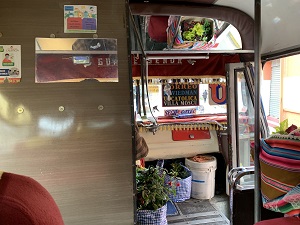 Photo: The buses in Bolivia are brightly colored, they look happy to me!
Photo: The buses in Bolivia are brightly colored, they look happy to me!
That’s my growing edge to work on. I will no doubt have more experiences of otherness in my time here. And yet, I know that I am called to find connection and relationship, not difference. And so, I will continue to do just that because that’s one of the ways I know how to share my love.
Buenas tardes mis amigos!
Photo: Even the insides of the buses here have colorful decorations. I really like them!
Photo of the Week - Week 24
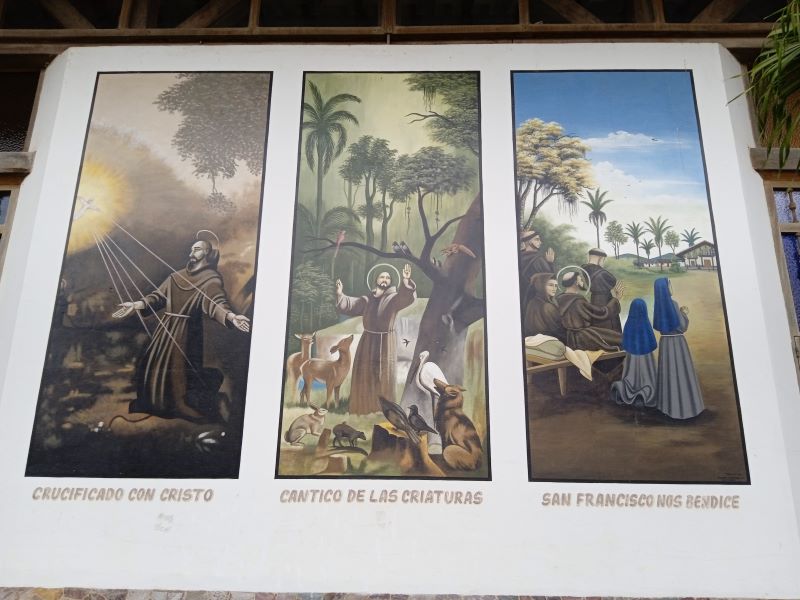
This incredible work of art is painted on the wall of the church in Ascención. It's on the parish side, which is opposite the convent. In other words, I have to walk through the church and outside to see it. At first, it seems like a nice mural depicting three times in Francis' life. When he received the stigmata (the wounds of Christ), preaching to creation, and the blessing of St. Francis.
As I looked closer though, I realized that the three scenes are set in Ascención! The trees and flowers are those found here. The animals in the center that are depicted include a macaw, stork, pigeons, swallows and I'm pretty sure that little creature in the center is a Jochie! (I still don't know how to spell that!) Even the dog that is sitting so regally reminds me of the German Shepherd, Rex, who guards the parish in the evenings. Finally, the last painting depicts the Tertiary Sisters of Saint Francis next to St. Francis, stepping in for the Poor Clares as Francis blesses the church and pueblo.
Artistry that tells a story is probably my favorite kind of art, but this goes even further, bringing the pueblo into the story.
If you want to see a full-size version of this art, you can get to it by clicking here.
Sister Ronalda: I need to live and love
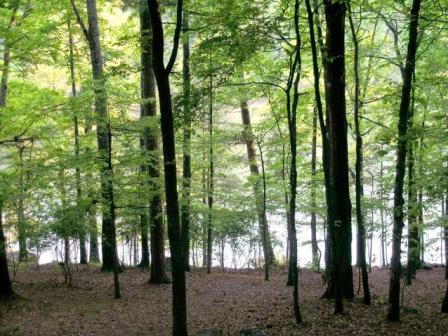
Image courtesy freeimages.com
Some of my best moments in prayer come when I am walking. Once, I was on a road in the woods. A grouping of tall pines with branches only at the top brought to my mind those who believe their presence lies “above” others. Another tree, covered in lichen, reminded me that I carry inner baggage that I need to get rid of. And I saw another tree that had been through a storm and the top was torn off.
My heart in the middle of my being is very important.
I need to live and love.
Franciscan Way is a series featuring prayerful reflection by Franciscan Sisters of Perpetual Adoration.
Photo of the Week - Week 16
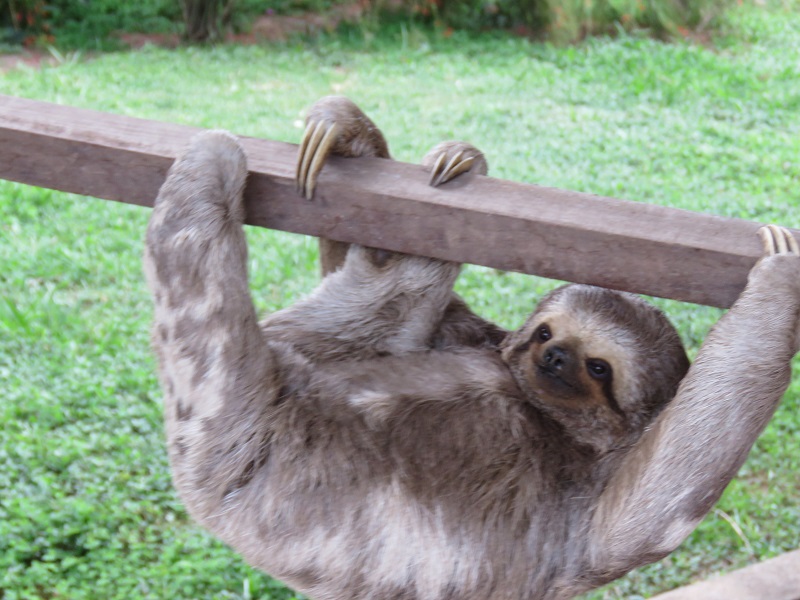
Look who came to the convent for a visit! Can you believe it? It was late in the afternoon on Monday and all of a sudden, everyone was talking excitedly and someone told me to get my camera. I couldn't believe it when out of the church came this totally adorable, young, three-toed sloth! I snapped photos and took a quick video (which you can see here if you are interested) and the sloth continued on the adventure of a lifetime (I am sure) being relocated to a more suitable spot. My first thought was the sloth was actually IN the church but after a few questions, I learned that "Iglesia" refers to the whole parish property. It's still too busy of a place here in the pueblo for this little one so I am glad people pitched in to help.
I also saw a friendly Brown Agouti who I was planning on including in the photo of the week but there's something about the adorableness of a sloth that wins out every time! The Agouti is a subspecies specific to this area. If you are interested, I have a short video here!
If you would like to be notified when I have new posts, be sure to scroll to the bottom, provide your email address, check the box confirming you are not a robot, click on a few photos to prove it and click Subscribe! You will then receive an email after each new post.
Encuentro in Cooking - Lessons in Life
This week, I have noticed the dance that difficulties and love play here. In the struggle of living in really difficult situations, mothers and grandmothers still make jokes and laugh while they work. A young mother who feeds her baby before herself smiles broadly when she is told how beautiful her baby is. I realize I have a choice, too. It’s possible for me to focus only on the struggle or only on the love. I am deciding to honor them both and see the harmony in the totality of the reality here.
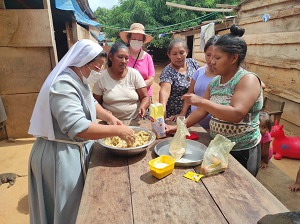
Now that carnaval has ended, Sister Yanira and I are back to our ministry at the nutrition clinic. On Thursday, we made plans to return to a large family we had previously visited to demonstrate how to use soybeans. Called soya here, soybeans are included in what people receive from the clinic. Sister Yanira packed up some educational materials about hygiene in addition to two cups of soybeans that had been soaked overnight, bread crumbs, some oil, vanilla, cinnamon and a blender. We also stopped at the market, an open-air area that has booths filled with all different types of food. We picked up carrots, onions, garlic, a pepper, a couple tomatoes, flour and some eggs.
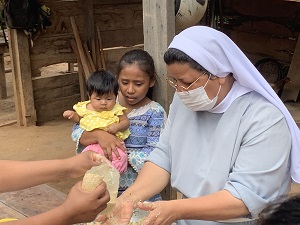 When we arrived at the house, a bunch of the kids greeted us with big smiles and lots of laughter. The first time we came, they were shy and unsure, but they must have decided that we were safe because they were so happy to see us. A table was moved, a bench placed in front and the youngest children quickly sat down, ready to learn. We were joined by older siblings, some to greet us and do other things, others stay and help with the children, preparations and cooking. The grandmother and the two mothers got things ready for our time together, cleaning everything we planned to use.
When we arrived at the house, a bunch of the kids greeted us with big smiles and lots of laughter. The first time we came, they were shy and unsure, but they must have decided that we were safe because they were so happy to see us. A table was moved, a bench placed in front and the youngest children quickly sat down, ready to learn. We were joined by older siblings, some to greet us and do other things, others stay and help with the children, preparations and cooking. The grandmother and the two mothers got things ready for our time together, cleaning everything we planned to use.
Sister Yanira gave the beans to one of the women to cook for some time on the stove in their kitchen. As Sister Yanira worked, she would show the process and then pass it on to one of the women. I appreciated that. It wasn’t a demonstration. It was a social time, where we talked, laughed and enjoyed each other’s company while we worked together. A couple more moms and children appeared, interested in learning what was happening and joining in the work.
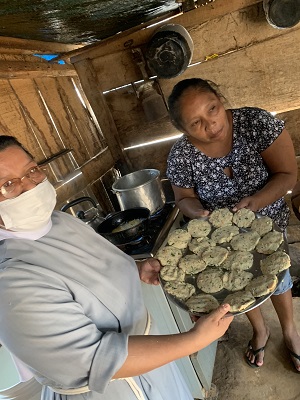 At some point, the kids lost interest and left to play in the yard as we worked. Dogs and chickens lingered nearby ready to pick up whatever we might drop. All the work was done in the center of the yard. There were multiple buildings surrounding us, all made with the repurposed wood, metal roofs and dirt floors. There was a small building for a living area, another for a kitchen and an outhouse toward the back of the yard. The yard contained some trees for shade and/or fruit. There was no grass, only packed dirt.
At some point, the kids lost interest and left to play in the yard as we worked. Dogs and chickens lingered nearby ready to pick up whatever we might drop. All the work was done in the center of the yard. There were multiple buildings surrounding us, all made with the repurposed wood, metal roofs and dirt floors. There was a small building for a living area, another for a kitchen and an outhouse toward the back of the yard. The yard contained some trees for shade and/or fruit. There was no grass, only packed dirt.
We were working with two cups of soybeans. It was incredible what we were able to produce with those two cups. The process took about 2 hours, but was well worth it! We ended up with 4 liters of soy milk and 30 or so small soy burgers. We all washed up when it was time to eat. The prepared food was shared with everyone. I sat with the younger children and loved watching them enjoy the food. both the burgers and the soy milk were delicious - Mi gusta!!!
 If you are interested in the recipes to try yourself, click on the little image to the right to view them. Warning! They're in Spanish, but you can use Google to figure out the words you don't know. That's what I did!
If you are interested in the recipes to try yourself, click on the little image to the right to view them. Warning! They're in Spanish, but you can use Google to figure out the words you don't know. That's what I did!
Click on the images below to see videos from the day. I had a great time and I think it's clear, the food was a hit!
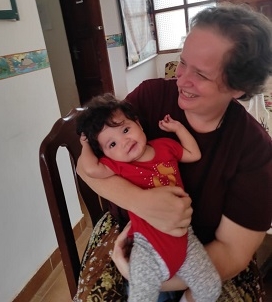
On Friday, a young mother came in with Elsa, a beautiful baby girl. The mom was so skinny, we worried for her. Elsa was a happy little baby though, and her mom let me take a photo with her. I thanked her for the photo, and felt gratitude for her good care – as well as gratitude that the clinic will help make sure Elsa has what she needs each month.
P.S. For the sisters at St. Rose who have been praying for Carlita and her family, thank you! She is doing better, and is in the hospital in Santa Cruz where she needs to be. For those who have time for an extra prayer, she is a 15 year old girl who has Leukemia. Her family has many struggles including extreme poverty and a bed-ridden grandma. Your prayers are just what they need right now. Muchas gracias!
If you would like to be notified when I have new posts, be sure to scroll to the bottom, provide your email address, check the box confirming you are not a robot, click on a few photos to prove it and click Subscribe! You will then receive an email after each new post.
A Day of Ministry with the Santa Clara Nutrition Center
Question:
What do you do at the nutrition center? Do you go there just once a day according to your "daily routine"?
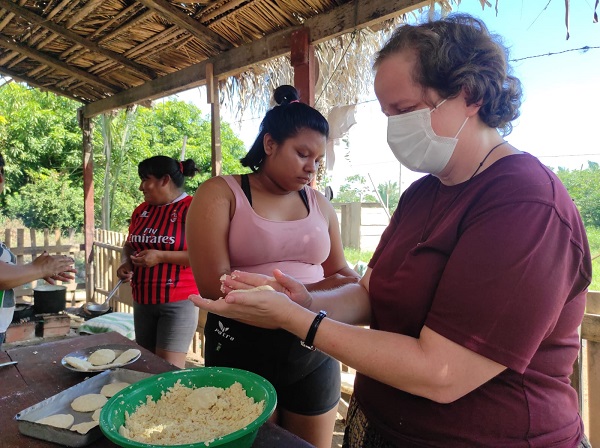 Response:
Response:
I really enjoy my ministry at the Santa Clara Nutrition Center and appreciate greatly the work that they do. We all work from 8 am to Noon.
Normally, we spend 2 or 3 days a week walking different neighborhoods and talking to parents about nutrition for their kids. I normally take photos, and Sister Yanira does all the talking. She is a nurse and uses that knowledge to help in different ways.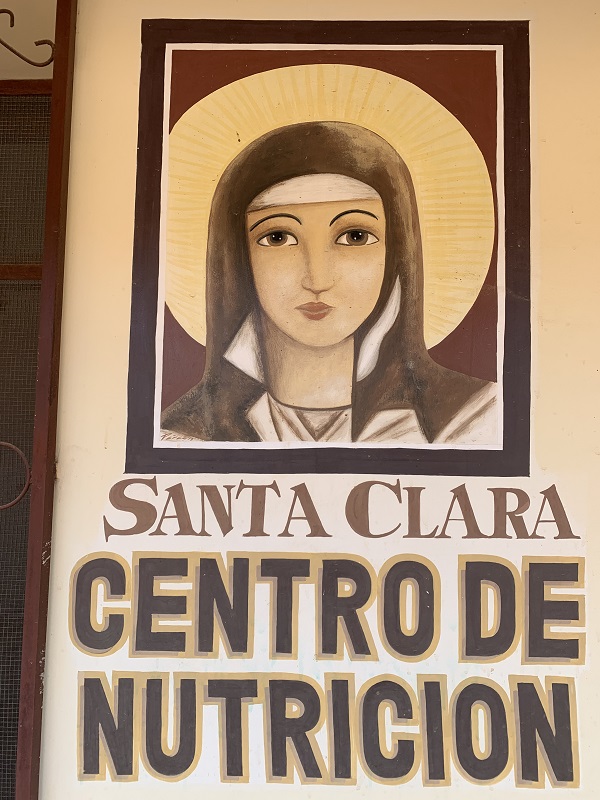
We try to cook with a family once a week, which gives Sister Yanira the opportunity to bring educational material for parents and kids to learn about things like nutrition and hygiene. I think cooking might be my favorite activity because it's a time for everyone to work together to make amazing food with soy that is high in nutrients and protein for families who might not have access to a lot of healthy food, especially meat.
Finally, a day is spent in the clinic. Sister Yanira works with families and I spend my time transcribing things on the computer or looking for photos on the internet for her to use in her educational talks.
We have participated in fairs in the neighborhoods as well, impressing people with delicious food made from soy. It's really all delicious! We also have information and conversations about nutrition and hygiene.
This is a description of a typical day walking the neighborhood:
It's 8:30 and the van arrives to take us to a neighborhood. As we drive, the van bounces over potholes and puddles, going slowly where water has washed away parts of the road.
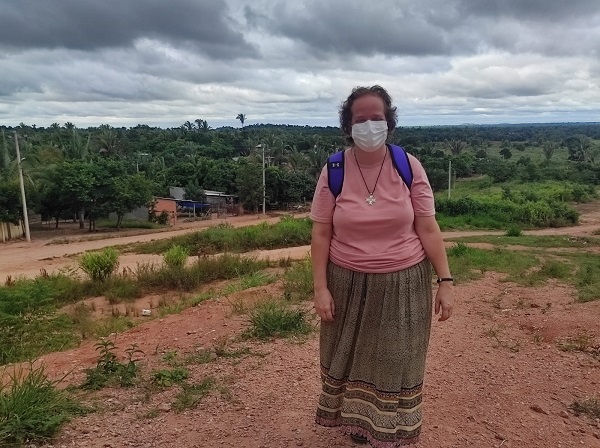 When we arrive at the Eva Morales barrio (neighborhood), we hop out of the van with our backpacks and the van leaves us, on its way to help run other errands for the sisters and act as transportation for the Tao school down the block from the center, which provides education to special needs and undocumented children.
When we arrive at the Eva Morales barrio (neighborhood), we hop out of the van with our backpacks and the van leaves us, on its way to help run other errands for the sisters and act as transportation for the Tao school down the block from the center, which provides education to special needs and undocumented children.
We begin to walk. This neighborhood happens to be in a more hilly area, so it's a bit more work. The sun is hot, and temperatures at the beginning of the day are normally in the low to mid-80s. It will get into the 90s before our walk is done. They are all dirt roads here, sometimes only passable on motorcycles or by walking. We hop over gullies and holes, sometimes slipping a bit on the loose rocks. Our sandals are covered with dust and dirt quickly.
As we walk, we talk about life, our faith and ourselves. We might stop for a minute or two to enjoy a flower, tree, insect or bird. Not too much time though, because we are on a mission!
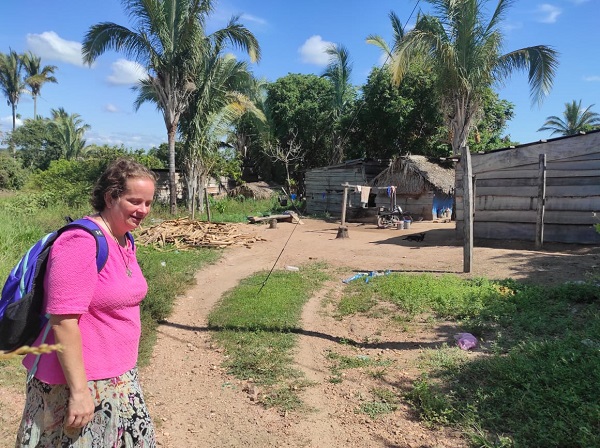 As we near different homes, we scan the clotheslines for children's clothes. I think it's such a smart way to see if we should stop. People hand wash clothes here, and as you can guess, there are always kid's clothes being cleaned! If we see them or see kids playing in the yard, we stop.
As we near different homes, we scan the clotheslines for children's clothes. I think it's such a smart way to see if we should stop. People hand wash clothes here, and as you can guess, there are always kid's clothes being cleaned! If we see them or see kids playing in the yard, we stop.
Normally, there is a gate made of re-purposed wood and barbed wire. Interestingly, a lot of people use their barbed wire fences as drying lines as well. One of the many examples of how things are well used here - I am often surprised and inspired by things like this. Sometimes a dog or two will come to challenge our entry. In many places, dogs are more protectors than family friends.
Sister Yanira shouts a bit of a greeting and we are welcomed into the yard. Most times, the general living area is outside. There may be one building or multiple smaller buildings of re-purposed wood and dirt floors for bedrooms, bathrooms and kitchens.
We are welcomed to an area that, if it was in a house, would likely be called the dining room. It's more like a porch here, with a covering to keep out the sun, and a table similar to a picnic table, where the family eats. First thing, chairs are produced for each of us. It is an incredibly welcoming gesture to me that is repeated for us in almost every place we visit.
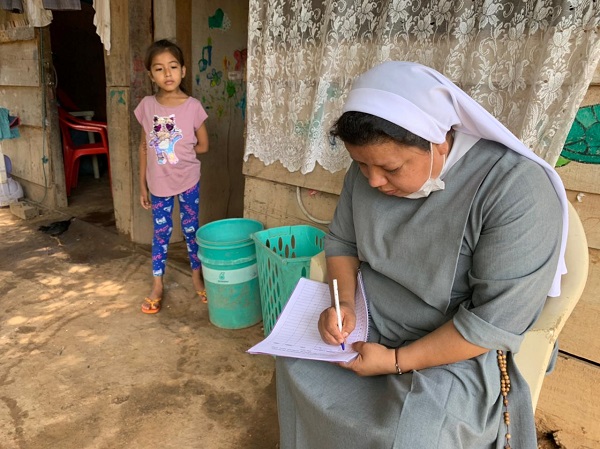 This family includes a mom, a grandma and three kids. It is often the case, not always, that fathers are not present. I don't have specifics on the reasons, but it proves to be a challenge for the mothers who many times team up with their moms and possibly their sisters and their sister's children who are in the same situation.
This family includes a mom, a grandma and three kids. It is often the case, not always, that fathers are not present. I don't have specifics on the reasons, but it proves to be a challenge for the mothers who many times team up with their moms and possibly their sisters and their sister's children who are in the same situation.
The kids are normally a bit shy the first time we see them. Reserved and not sure what to make of us. They are curious about Sister Yanira in her habit and listen when their mom tells them to come over to us, but they are not ready to trust us yet.
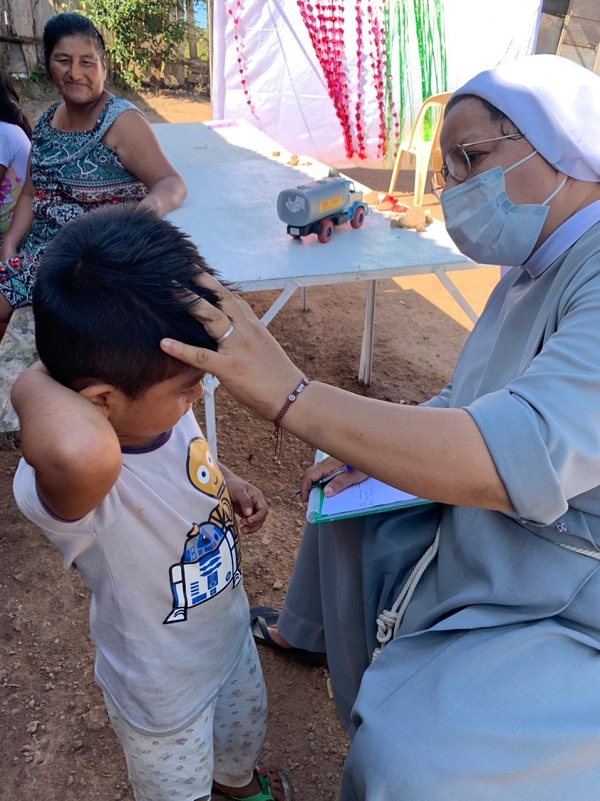 Sister Yanira will check the kids, talk about nutrition, give medical advice, discuss education options for undocumented* kids and help if there is an urgent situation.
Sister Yanira will check the kids, talk about nutrition, give medical advice, discuss education options for undocumented* kids and help if there is an urgent situation.
We might schedule a cooking demonstration with a family, but we always provide information about the clinic and directions on how to get there.
As we leave, we thank the parents and say 'chao' to the kids. Now that we're leaving, smiles appear and return 'chaos' ring out from the kids. When we return in the future, most kids are transformed into interested, engaged, trusting children. It is a blessing to receive the gift of their trust.
We will repeat this process five or more times before we run out of time at about 11:30. Sometimes we are revisiting people who have received help before. Sometimes we are checking in on abuelas and abuelos (grandmothers and grandfathers) with health issues. Other times, we meet a child with special needs along with their brothers and sisters, presenting a different kind of challenge for a family here.
Sometimes when we visit a family, we find a chunky baby and kids that are a good weight. These times are not the norm however -- maybe one family of every five or six. Sister Yanira always celebrates these mothers, lifting them up with great praise and affirmation of the great job they are doing.
Finally, it's time to return. We hop on separate motorcycles and arrive back at the center with enough time for Sister Yanira to follow up on the takeaways she leaves the neighborhood with, put away our things and talk with the other staff there about each other's days.
*I wondered about what it means to be undocumented here. I wasn't sure if it was the same thing as in the United States. Here, undocumented kids are kids whose parents have not registered them. Both parents' signatures are required, and many times the fathers don't want to take responsibility for the child so they don't sign. Unregistered kids don't have access to healthcare or education. This puts moms in a very tough place. The Tao school provides education to these children.
If you would like to be notified when I have new posts, be sure to scroll to the bottom, provide your email address, check the box confirming you are not a robot, click on a few photos to prove it and click Subscribe! You will then receive an email after each new post.
Photo of the Week - Week 11
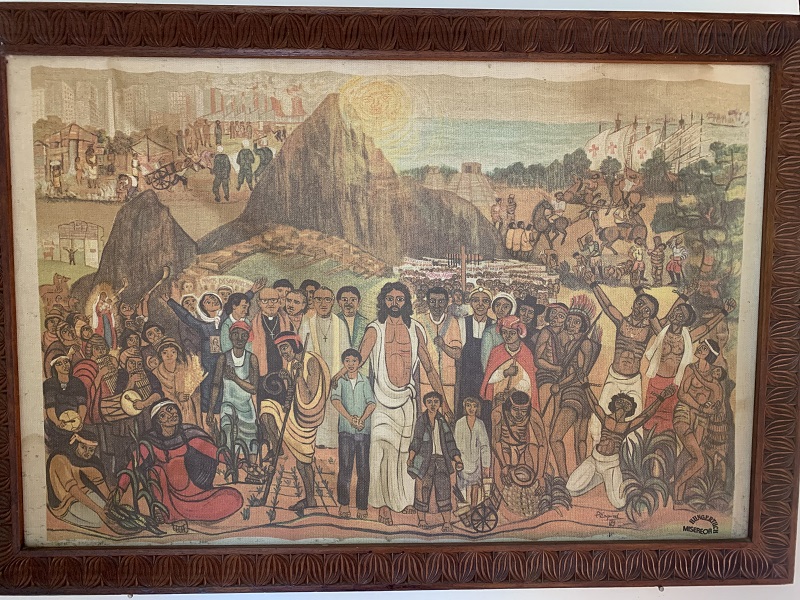
This week's photo is from the convent in San Miguel where I spent some time last week. I have seen different art like this here in Bolivia, but the imagery in this one struck me more than the others. This type of art serves as a reminder of the history of the place. In here you see Jesus front and center surrounded by indigenous people, priests, workers, poor children and freed slaves. Behind it you can see some of the historical events that happened like the arrival of the Spanish, military oppression and protests. I don't know the specific historical stories depicted in this painting, but it moves me. It reminds me of the history we are exploring anew in the United States connected to historical trauma and systemic racism (and other "isms") and I wonder what art is being created back in the states that will tell the story of our history. It will be good to see the images the future brings.
I realized that it is difficult to see all the detail in this photo so I have made the original available here for anyone interested.
If you would like to be notified when I have new posts, be sure to scroll to the bottom, provide your email address, check the box confirming you are not a robot, click on a few photos to prove it and click Subscribe! You will then receive an email after each new post.
The Making of a Saint - and Nerviness
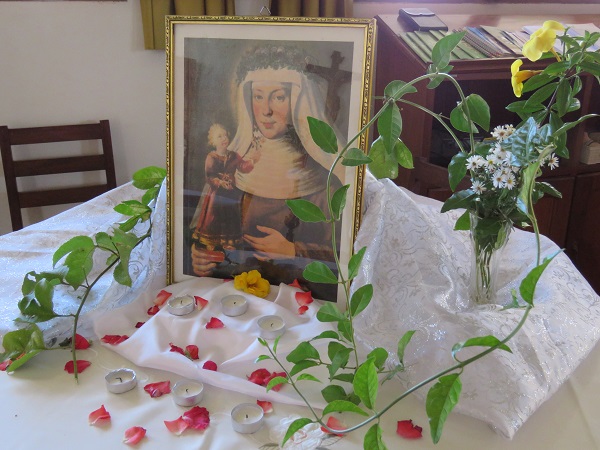 Today is the feast day of Madre Maria Hueber, the founder of the Tertiary Sisters of St. Francis, the sisters I am living with here in Bolivia. They have provinces in Austria, Bolivia and Cameroon. Madre Maria seemed to be a simple woman who accomplished miraculous things devoted to free education for children as she had the gift of prophecy.
Today is the feast day of Madre Maria Hueber, the founder of the Tertiary Sisters of St. Francis, the sisters I am living with here in Bolivia. They have provinces in Austria, Bolivia and Cameroon. Madre Maria seemed to be a simple woman who accomplished miraculous things devoted to free education for children as she had the gift of prophecy.
The sisters here created special displays for the venerated sister, one in the dining room and one in the chapel. I appreciate so much that they used cuttings from the plants in the garden. It's such a simple but beautiful expression of Franciscan simple living. There are candles and lovely fabrics that grace the places. Last night for the solemnity we had some time in Adoration and today we had a feast of "Chancha" (roasted pork) at lunch and read a special prayer for her day after, which I was lucky enough to get to read.
It is my turn to lead pray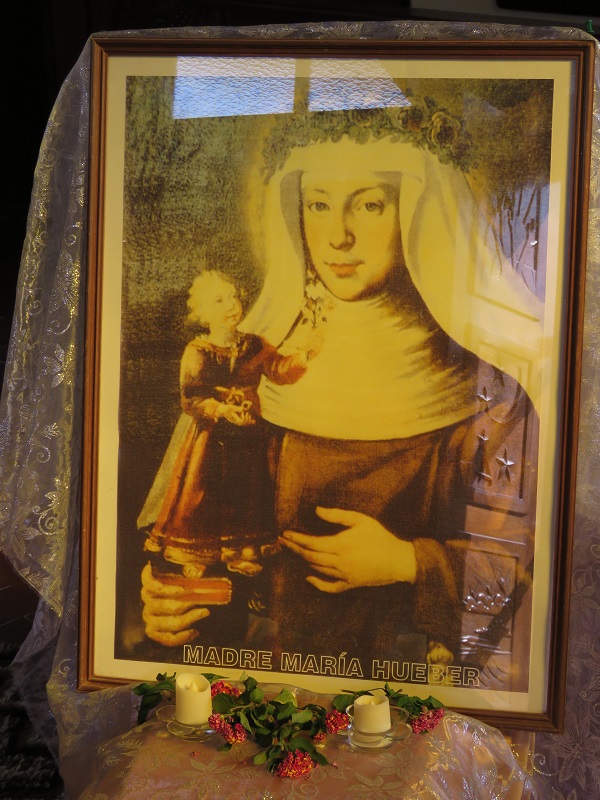 ers this week. I tried to talk them out of it, but they wouldn't budge. I guess that means if I make mistakes, they only have themselves to blame! Just kidding, I have been practicing and preparing, but considering it's entirely in Spanish, that complicates things for me and my language capacity. It's a good challenge though, and I am confident that the sisters will help me with everything as I need it. As a matter of fact, I started last night, and I mixed up the order of things for Adoration, which at times they ignored and when needed, started a prayer when I began doing something else. I appreciate they're guiding help and willingness to be patient as I lean into this good - but nerve-wracking - time.
ers this week. I tried to talk them out of it, but they wouldn't budge. I guess that means if I make mistakes, they only have themselves to blame! Just kidding, I have been practicing and preparing, but considering it's entirely in Spanish, that complicates things for me and my language capacity. It's a good challenge though, and I am confident that the sisters will help me with everything as I need it. As a matter of fact, I started last night, and I mixed up the order of things for Adoration, which at times they ignored and when needed, started a prayer when I began doing something else. I appreciate they're guiding help and willingness to be patient as I lean into this good - but nerve-wracking - time.
Since it was the Solemnity of the Feast of Venerable Madre Maria Hueber, I decided to ask her to put in a good word for me, and interestingly, the readings and prayers I had to say solo went very well. She is being considered for canonization (becoming a saint) and I think that my saying the prayers and readings well should count as a miracle and cause toward furthering her in the process!
Knowing that each day I have four prayer times in the chapel, two meals at which to say grace (at the beginning and end none-the-less!), a rosary, Adoration and one reading after lunch, I probably could use a lot more intercessions for help with this important task with the sisters. Did I mention it's entirely in Spanish? In other words, please pray for me! Muchas Gracias!
If you would like to be notified when I have new posts, be sure to scroll to the bottom, provide your email address, check the box confirming you are not a robot, click on a few photos to prove it and click Subscribe! You will then receive an email after each new post.


